Medical Mystery: What turned a little boy’s knuckles yellow?
On both of the 4-year-old's hands, there was a faint discoloration, a faint yellowness of each knuckle.

I conducted a routine physical for a 4-year-old boy who had no past medical history except for a visit to the emergency room for swallowing a quarter when he was 3. His growth and development were perfect.
His mother had no concerns, and his physical exam initially was normal. I ordered his 4-year-old vaccinations and, as I routinely do before moving on to the next patient, asked his mother, "What questions do you have?"
She paused and initially said, "None." As I reached for the doorknob to go on to my next patient, his mother apologized. "Sorry, doctor, I forgot to ask about this rash on his knuckles." She pointed to the knuckles on both his hands, where there was a faint discoloration, a faint yellowness to each knuckle.
I asked about diet, knowing that some children who eat a lot of carrots, rice, or sweet potatoes can get a benign discoloration of the skin called carotenemia. "Yeah," she said, "he could go through a bag of carrots if I let him." I smiled, thinking that this was one healthy, veggie-loving boy.
That was, until his grandmother brought him in for a sick visit two weeks later, worried that he was more tired than usual and just "not himself." I looked at his grandmother's eyelids and re-evaluated my whole approach to this little boy.
Solution
On each of his grandmother's eyelids were telltale yellowish nodules called xanthomas, a word derived from Greek meaning yellow. Xanthomas are deposits of cholesterol under the skin that are associated with high levels of fats, like cholesterol. I re-examined her grandson to look for other signs of high cholesterol besides the yellowing of his knuckles.
I looked closely at his eyes and noticed a small arch of gray at the top of his iris. It could be a normal variant, I thought, or a corneal archus, which could be a sign of high cholesterol. The rest of his exam was normal, until I took his socks off. On each of his Achilles tendons were small masses toward the end of his Achilles.
My heart sank as I sent him into our laboratory to investigate whether these were signs of homozygous familial hypercholesterolemia, a rare condition in which children inherit a gene from each parent that causes them to have dysfunction in their LDL (bad cholesterol) receptors, so they cannot get rid of LDL in their blood.
There are only about 2,000 patients in the United States with this condition. Without appropriate lifetime treatment, it can lead to very early heart disease in the teen years.
The boy's cholesterol level came back very high, over 800 (normal should be under 130). I referred the boy to a lipid specialist who recommended LDL apheresis, in which LDL cholesterol is physically removed through the bloodstream.
The little boy was put on lifelong lipid-lowering drugs, which have controlled his LDL cholesterol — but not his love of carrots.
Daniel R. Taylor, D.O., FAAP, FACOP, is an associate professor at Drexel University College of Medicine and director of community pediatrics and child advocacy at St. Christopher's Hospital for Children.